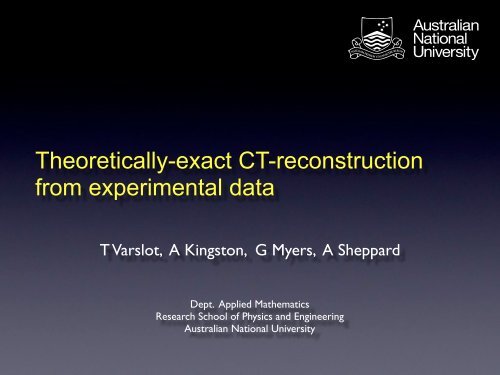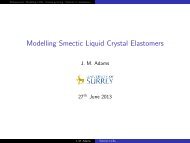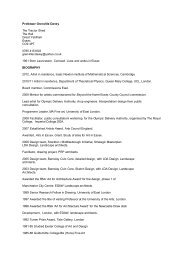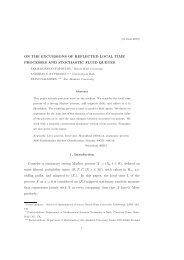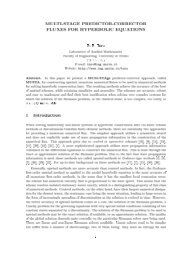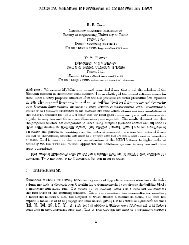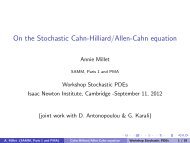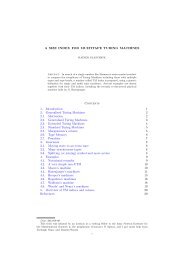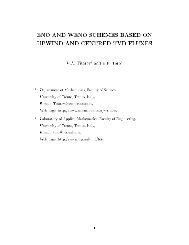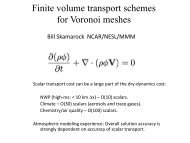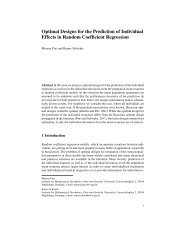et al.
et al.
et al.
Create successful ePaper yourself
Turn your PDF publications into a flip-book with our unique Google optimized e-Paper software.
Theor<strong>et</strong>ic<strong>al</strong>ly-exact CT-reconstruction<br />
from experiment<strong>al</strong> data<br />
T Varslot, A Kingston, G Myers, A Sheppard<br />
Dept. Applied Mathematics<br />
Research School of Physics and Engineering<br />
Austr<strong>al</strong>ian Nation<strong>al</strong> University
Can we reconstruct an object from X-ray<br />
projections?
Can we reconstruct an object from X-ray<br />
• In 2D: reconstruction of a function<br />
from collection of 1D line<br />
integr<strong>al</strong>s. [J. Radon, 1918]<br />
projections?
Can we reconstruct an object from X-ray<br />
• In 2D: reconstruction of a function<br />
from collection of 1D line<br />
integr<strong>al</strong>s. [J. Radon, 1918]<br />
projections?
Can we reconstruct an object from X-ray<br />
• In 2D: reconstruction of a function<br />
from collection of 1D line<br />
integr<strong>al</strong>s. [J. Radon, 1918]<br />
projections?
Can we reconstruct an object from X-ray<br />
• In 2D: reconstruction of a function<br />
from collection of 1D line<br />
integr<strong>al</strong>s. [J. Radon, 1918]<br />
projections?
Can we reconstruct an object from X-ray<br />
• In 2D: reconstruction of a function<br />
from collection of 1D line<br />
integr<strong>al</strong>s. [J. Radon, 1918]<br />
• In 3D: Radon and X-ray<br />
transforms are different<br />
• 3D Radon transform: 1D<br />
projection data resulting from<br />
2D integr<strong>al</strong>s<br />
• 3D X-ray transform: 2D<br />
projection data resulting from<br />
1D line integr<strong>al</strong>s.<br />
projections?
Can we reconstruct a 3D object from 2D<br />
• Tuy 1983, Kirillow 1961<br />
• condition for trajectory to facilitate exact<br />
reconstruction from cone-beam projections<br />
• Feldkamp <strong>et</strong> <strong>al</strong>., 1984<br />
• extension of 2D filtered backprojection with<br />
circle trajectory to 3D (cone-beam)<br />
• works well in many practic<strong>al</strong> applications<br />
• artefacts for high cone-angle<br />
• Danielsson <strong>et</strong> <strong>al</strong>., 1997<br />
• Each object point lies on a unique PI-line<br />
(helix trajectory)<br />
X-ray projections?<br />
“ ... To accurately reconstruct an image for a ROI, <strong>al</strong>l the<br />
planes passing through the ROI should intersect the<br />
source trajectory at least once in a nontangenti<strong>al</strong> and<br />
nonended way. ... “<br />
Tuy, “An inverse formula for cone-beam reconstruction,” SIAM J Appl. Math., 1983.
Can we reconstruct a 3D object from 2D<br />
• Tuy 1983, Kirillow 1961<br />
• condition for trajectory to facilitate exact<br />
reconstruction from cone-beam projections<br />
• Feldkamp <strong>et</strong> <strong>al</strong>., 1984<br />
• extension of 2D filtered backprojection with<br />
circle trajectory to 3D (cone-beam)<br />
• works well in many practic<strong>al</strong> applications<br />
• artefacts for high cone-angle<br />
• Danielsson <strong>et</strong> <strong>al</strong>., 1997<br />
• Each object point lies on a unique PI-line<br />
(helix trajectory)<br />
X-ray projections?
Why helic<strong>al</strong> micro-CT?<br />
• Image long objects<br />
• multiple circular scans<br />
• one helic<strong>al</strong> scan<br />
• Acquisition time<br />
• b<strong>et</strong>ter use of X-ray flux<br />
• improved SNR, faster imaging<br />
• Imaging artefacts<br />
• circular micro-CT: 10 degrees<br />
• our helic<strong>al</strong> micro-CT: 50 degrees
Why helic<strong>al</strong> micro-CT?<br />
• Image long objects<br />
• multiple circular scans<br />
• one helic<strong>al</strong> scan<br />
• Acquisition time<br />
• b<strong>et</strong>ter use of X-ray flux<br />
• improved SNR, faster imaging<br />
• Imaging artefacts<br />
• circular micro-CT: 10 degrees<br />
• our helic<strong>al</strong> micro-CT: 50 degrees<br />
R<br />
R<br />
L<br />
Cone<br />
angle<br />
L<br />
Cone<br />
angle
Why helic<strong>al</strong> micro-CT?<br />
• Image long objects<br />
• multiple circular scans<br />
• one helic<strong>al</strong> scan<br />
• Acquisition time<br />
• b<strong>et</strong>ter use of X-ray flux<br />
• improved SNR, faster imaging<br />
• Imaging artefacts<br />
• circular micro-CT: 10 degrees<br />
• our helic<strong>al</strong> micro-CT: 50 degrees
Why helic<strong>al</strong> micro-CT?<br />
• Image long objects<br />
• multiple circular scans<br />
• one helic<strong>al</strong> scan<br />
• Acquisition time<br />
• b<strong>et</strong>ter use of X-ray flux<br />
• improved SNR, faster imaging<br />
• Imaging artefacts<br />
• circular micro-CT: 10 degrees<br />
• our helic<strong>al</strong> micro-CT: 50 degrees<br />
Artefacts from sampling, not geom<strong>et</strong>ry!
P<br />
• Varian Paxscan flat panel<br />
• 2048 x 1536 pixels<br />
• ~ 400mm x 300mm<br />
• Rail-mounted sample stage<br />
• Phoenix nano-focused source<br />
Source<br />
rotation/translation axis<br />
R<br />
L<br />
Hardware<br />
D<strong>et</strong>ector<br />
v<br />
u
Reservoir<br />
carbonate<br />
• 556mm camera length<br />
• 60mm sample distance<br />
• 30 micron voxel size
But the results are not great ...<br />
Berea sandstone ~2.8 micron voxel size
•<br />
•<br />
•<br />
discr<strong>et</strong>e implementation<br />
noise in the data<br />
hardware <strong>al</strong>ignment<br />
• 9 param<strong>et</strong>ers for geom<strong>et</strong>ric<br />
<strong>al</strong>ignment<br />
• consistent sensitivity an<strong>al</strong>ysis<br />
Awful results: why?<br />
P<br />
Source<br />
rotation/translation axis<br />
R<br />
L<br />
D<strong>et</strong>ector<br />
W<br />
v<br />
u<br />
H
1.0ou change in <strong>al</strong>ignment param<strong>et</strong>er<br />
changes backprojected rays through the<br />
volume of the order of 1 d<strong>et</strong>ector pixel.<br />
For example:<br />
1.0ou<br />
L =<br />
leads to for horizont<strong>al</strong> offs<strong>et</strong><br />
1.0ou =<br />
W/N<br />
L +(W/2) cos αf<br />
W/N<br />
1+(W/2L) cos αf<br />
Optim<strong>al</strong> units<br />
= W/N<br />
1 + sin αf<br />
P<br />
Source<br />
rotation/translation axis<br />
R<br />
L<br />
D<strong>et</strong>ector<br />
W<br />
v<br />
u<br />
H
1.0ou change in <strong>al</strong>ignment param<strong>et</strong>er<br />
changes backprojected rays through the<br />
volume of the order of 1 d<strong>et</strong>ector pixel.<br />
L=330mm, W=400mm, H=300mm, M=2048, N=1536<br />
Optim<strong>al</strong> units<br />
P<br />
Source<br />
rotation/translation axis<br />
R<br />
L<br />
D<strong>et</strong>ector<br />
Require precision to within 0.5<br />
d<strong>et</strong>ector pixel<br />
Hardware not sufficiently accurate<br />
W<br />
v<br />
u<br />
H
Sample distance mis<strong>al</strong>ignment
D<strong>et</strong>ector offs<strong>et</strong> mis<strong>al</strong>ignment
Optimisation-based<br />
reconstruction<br />
Image sharpness:<br />
sh(f) :=||∇f||2
Optimisation-based<br />
reconstruction<br />
Image sharpness:<br />
sharpness<br />
1.4<br />
1.2<br />
1<br />
0.8<br />
8<br />
sh(f) :=||∇f||2<br />
6<br />
R [mm]<br />
4<br />
−10<br />
0<br />
10<br />
D W [mm]<br />
20
Fast Filtered Backprojection<br />
• “Feldkamp with a twist”<br />
• Horizont<strong>al</strong> ramp filter<br />
• Backproject entire projection without weighting<br />
factors<br />
• Correct geom<strong>et</strong>ry backprojects<br />
edges to correct location<br />
• Maxim<strong>al</strong> inconsistency when<br />
geom<strong>et</strong>ry is incorrect<br />
v [mm]<br />
−150<br />
−100<br />
−50<br />
0<br />
50<br />
100<br />
150<br />
−200 −150 −100 −50 0<br />
u [mm]<br />
50 100 150 200
Katsevich<br />
FFBP<br />
Horizont<strong>al</strong> d<strong>et</strong>ector offs<strong>et</strong>
Optimisation-based<br />
reconstruction<br />
Image sharpness:<br />
Norm<strong>al</strong>ised sharpness<br />
Norm<strong>al</strong>ised sharpness<br />
1.4<br />
1.2<br />
1<br />
0.8<br />
8<br />
1.4<br />
1.2<br />
1<br />
0.8<br />
0.6<br />
0.4<br />
0.2<br />
sh(f) :=||∇f||2<br />
6<br />
R [mm]<br />
4<br />
−10<br />
0<br />
10<br />
D W [mm]<br />
0<br />
4 5 6<br />
Sample distance [mm]<br />
7 8<br />
20<br />
Norm<strong>al</strong>ised sharpness<br />
Norm<strong>al</strong>ised sharpness<br />
1<br />
0.5<br />
8 0<br />
1<br />
0.8<br />
0.6<br />
0.4<br />
0.2<br />
6<br />
R [mm]<br />
4<br />
−10<br />
0<br />
10<br />
D W [mm]<br />
0<br />
−5 0 5 10 15 20<br />
Horizont<strong>al</strong> d<strong>et</strong>ector offs<strong>et</strong> [mm]<br />
20
Optimisation-based<br />
reconstruction<br />
Image sharpness:<br />
sh(f) :=||∇f||2<br />
• use FFBP to reconstruct image<br />
• structured search<br />
• “sequenti<strong>al</strong>ly decoupled” param<strong>et</strong>ers<br />
• slice-based reconstruction<br />
• computation O(N 4 ) becomes O(kN 3 )<br />
• full projection s<strong>et</strong> needed<br />
• loc<strong>al</strong> cache reduces MPI overhead<br />
• multi-resolution optimization:<br />
• computation O(kN 3 ) becomes O(k[N/q] 3 )<br />
• memory requirement O(N 3 ) becomes O([N/q] 3 )<br />
• trivi<strong>al</strong>ly par<strong>al</strong>lel at lowest level
•<br />
•<br />
Auto-focus <strong>al</strong>ignment<br />
post-processing of projection data<br />
reconstruct without exact geom<strong>et</strong>ry
•<br />
•<br />
Auto-focus <strong>al</strong>ignment<br />
post-processing of projection data<br />
reconstruct without exact geom<strong>et</strong>ry
Sample distance<br />
• 556mm camera length<br />
• 8mm sample distance<br />
• 2.8 micron voxel size
Sample distance<br />
• 556mm camera length<br />
• 8mm sample distance<br />
• 2.8 micron voxel size
Sample distance<br />
• 556mm camera length<br />
• 8mm sample distance<br />
• 2.8 micron voxel size
Sample distance<br />
• 556mm camera length<br />
• 8mm sample distance<br />
• 2.8 micron voxel size
Comparison<br />
old vs. new system<br />
old: 60mm@190mm. New: 400mm@382mm, 11h acc.
Comparison<br />
old vs. new system<br />
old: 60mm@190mm. New: 400mm@382mm, 11h acc.
Carbonate sample<br />
• 20mm by 5 mm sample<br />
• 4 revolutions of data<br />
• 1760 x 1760 x 6000 voxels<br />
• 3.5 micron voxel size<br />
• 400mm wide d<strong>et</strong>ector<br />
• 330mm camera length<br />
• >10x speed-up<br />
Circular scan with same camera length
Summary<br />
• b<strong>et</strong>ter SNR at high cone angle<br />
• good tomogram with 2048 3 from 4<br />
hours acquisition<br />
• routine imaging of long objects<br />
• successfully reconstructed tomogram:<br />
2048 x 2048 x 8192<br />
• limited by<br />
• acquisition time<br />
• disk space<br />
• computer memory<br />
• 100mm vertic<strong>al</strong> travel<br />
• currently ~1.5 micron resolution


